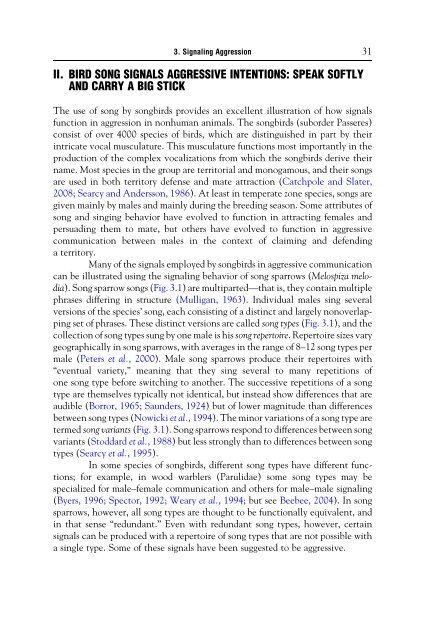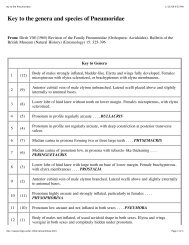full text - Caspar Bgsu - Bowling Green State University
full text - Caspar Bgsu - Bowling Green State University
full text - Caspar Bgsu - Bowling Green State University
Create successful ePaper yourself
Turn your PDF publications into a flip-book with our unique Google optimized e-Paper software.
3. Signaling Aggression 31<br />
II. BIRD SONG SIGNALS AGGRESSIVE INTENTIONS: SPEAK SOFTLY<br />
AND CARRY A BIG STICK<br />
The use of song by songbirds provides an excellent illustration of how signals<br />
function in aggression in nonhuman animals. The songbirds (suborder Passeres)<br />
consist of over 4000 species of birds, which are distinguished in part by their<br />
intricate vocal musculature. This musculature functions most importantly in the<br />
production of the complex vocalizations from which the songbirds derive their<br />
name. Most species in the group are territorial and monogamous, and their songs<br />
are used in both territory defense and mate attraction (Catchpole and Slater,<br />
2008; Searcy and Andersson, 1986). At least in temperate zone species, songs are<br />
given mainly by males and mainly during the breeding season. Some attributes of<br />
song and singing behavior have evolved to function in attracting females and<br />
persuading them to mate, but others have evolved to function in aggressive<br />
communication between males in the con<strong>text</strong> of claiming and defending<br />
a territory.<br />
Many of the signals employed by songbirds in aggressive communication<br />
can be illustrated using the signaling behavior of song sparrows (Melospiza melodia).<br />
Song sparrow songs (Fig. 3.1) are multiparted—that is, they contain multiple<br />
phrases differing in structure (Mulligan, 1963). Individual males sing several<br />
versions of the species’ song, each consisting of a distinct and largely nonoverlapping<br />
set of phrases. These distinct versions are called song types (Fig. 3.1), and the<br />
collection of song types sung by one male is his song repertoire. Repertoire sizes vary<br />
geographically in song sparrows, with averages in the range of 8–12 song types per<br />
male (Peters et al., 2000). Male song sparrows produce their repertoires with<br />
“eventual variety,” meaning that they sing several to many repetitions of<br />
one song type before switching to another. The successive repetitions of a song<br />
type are themselves typically not identical, but instead show differences that are<br />
audible (Borror, 1965; Saunders, 1924) but of lower magnitude than differences<br />
between song types (Nowicki et al., 1994). The minor variations of a song type are<br />
termed song variants (Fig. 3.1). Song sparrows respond to differences between song<br />
variants (Stoddard et al., 1988) but less strongly than to differences between song<br />
types (Searcy et al., 1995).<br />
In some species of songbirds, different song types have different functions;<br />
for example, in wood warblers (Parulidae) some song types may be<br />
specialized for male–female communication and others for male–male signaling<br />
(Byers, 1996; Spector, 1992; Weary et al., 1994; but see Beebee, 2004). In song<br />
sparrows, however, all song types are thought to be functionally equivalent, and<br />
in that sense “redundant.” Even with redundant song types, however, certain<br />
signals can be produced with a repertoire of song types that are not possible with<br />
a single type. Some of these signals have been suggested to be aggressive.



